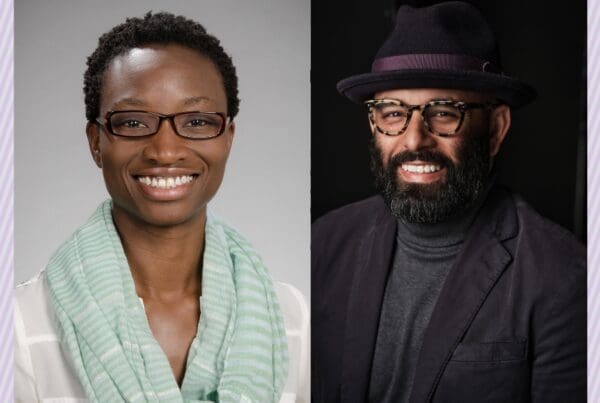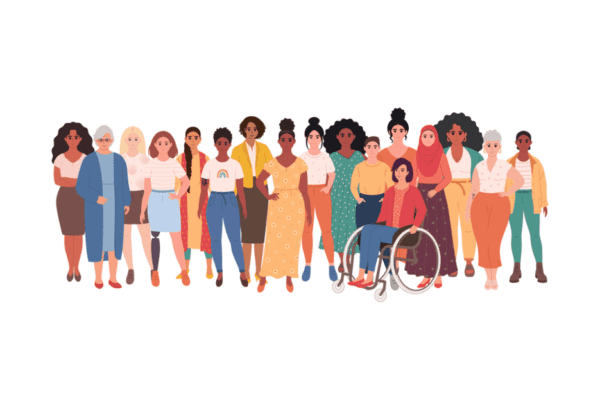This year’s theme for Hispanic and Latinx Heritage Month is Unidos: Stronger Together. And despite diverse backgrounds and experiences, these Hispanic and Latinx employees are united in love for their cultures.
They also shared some of their favorite things about their cultures and why it’s important to recognize that, even among all the differences and diversity of Hispanic and Latinx people, they are stronger together and have ties that unite them.
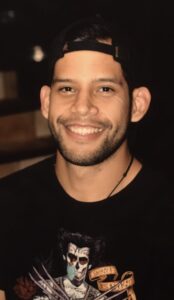
Aldo Monico Martinez
Aldo Monico Martinez, he/him, Patient Service Specialist
“I am a Mexican American born and raised in the San Fernando Valley. Both of my parents were born in Mexico; my father in Santa Fe, Guadalajara, and my mother in Mesillas, Zacatecas. For me, my culture/heritage is a feeling of home, a reminder to always remember where I come from and be proud of. As it’s a road built off hard work ethic, which has given me the opportunity not only to have a stable foundation to do anything but to make that path stronger for the next generation. I love being able to communicate with others who speak Spanish, especially at work because they prepare themselves to only show their cover but once they hear their native language, they become an open book.
I have many favorite artists but just to name a few that make me think of my family are Los Broncos, Los Yonics, Vicente Fernandez, Jose Jose, Jenny Rivera and Selena. In the case of food, there are so many which come to mind. For example, gorditas filled with various fillings like cheese, refried beans and egg, potato and chorizo. A few other dishes are sopes, red and green enchiladas, tacos, fried tacos and menudo. Then on the sweet end there’s gorditas de azucar, chuchulucos, bunuelos, churros and pan dulce.
I love the theme of Unidos: Inclusivity as it represents anyone who is different, has a disadvantage, disability or difficulty of some sort. It’s important to look out for them and make sure they are included in our plan of improving oneself. Inclusion matters, it is important to be aware because while everyone may need a helping hand, there are some who require two.
The theme also hits close to home because my little sister has cerebral palsy along with a few other difficulties, and it has been tough. For my parents, it was hard to grasp at first as they came from a culture and life that toughened them up at a very young age. Yet my sister introduced us into a world we would have just unintentionally avoided. Now we participate in a walk every year to raise money for Inclusion Matters by Shane’s Inspiration, an organization which uses the money to build inclusive, sensory- and literacy-rich playgrounds around the world.”
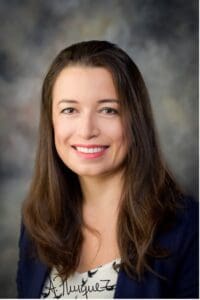
Alicia Fernanda Henriquez Quintero
Alicia Fernanda Henriquez Quintero, MD, she/her, Clinical Assistant Professor of Neurology
“I was born in Colombia and immigrated to the U.S. as a teenager. Although I have now lived more years in the U.S. than in Colombia, the values and traditions of my family and culture exist strong within me. Colombian culture has Native, European and African influences and it is rich with music, food and a strong love for family and friends.
I spend a lot of my free time dancing salsa and bachata. I enjoy listening to Vallenatos (Colombian country), Latin rock and even Reggaeton. While I love my Colombian sancocho, I often crave Mexican posole or Peruvian ceviche. I value family’s central role in Latin cultures and share the appreciation for hard work and perseverance. Part of our culture has been shaped by social inequalities, violence and civil wars that have pushed many to leave their home countries in search of a safer and better home. It is our sense of community and perseverance that helps us thrive in new environments.
Some of my favorite childhood memories are from Christmas time and the novenas in Colombia. During the novenas, we gather with family, friends and neighbors for nine days in a row to pray, dance, eat, play and drink. Colombians have an obsession with Christmas lights which light up the neighborhoods and cities with beautiful colors and make the holidays feel warmer and more festive.
The color of our skin, our gender, our height, our accent, our religious choices, the food we eat, and the language we speak should not determine our ability to access basic needs, education and healthcare. Projects such as the Spanish Language Clinics at Seattle Children’s Hospital aim to provide equitable care to Spanish-speaking families in their own language and in a culturally sensitive manner. These clinics provide families the tools to care for their children despite of their language or beliefs. This is what inclusive care should look like and more projects like these are needed in all areas.”
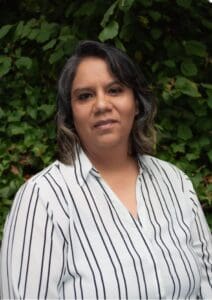
Blanca Guerrero Jaramillo
Blanca Guerrero Jaramillo, she/her, Environmental Services, Custodian
“I am a Mexican immigrant who was born in Lèon Guanajuato, México, and grew up in California and Washington since the age of nine. My culture/heritage not only is a story of where I come from but it’s also a part of what defines me as an individual. I am proud of the virtues and values that my culture and family have taught me; respect, sympathy, resilience and courage. I continue to speak Spanish and practice my faith and traditions not only because it is an important part of my identity, but also because I strive to pass down this cultural richness to my children. We are proud to identify as Mexicanos.
I come from a household of nine siblings so some of my favorite traditions are when we get together such as Navidad (Christmas). We have a house full of food like pozole, tamales, mole, champurrado and ponches. This is only naming a few! Enjoying our time being together with music and dancing. Some of my favorite music is cumbia, banda and Spanish rock.
Not only do I identify as a Mexicana but I am also a Latina. What this means to me is that I form part of a larger group of people that come from a similar background as me but who are not necessarily Mexicans. Our unity allows us to voice our rights and advocate for one another. This unity also helps us open up the diverse set of cultures that make up the Latinx/Hispanic community to our country, creating new perspectives for people.”
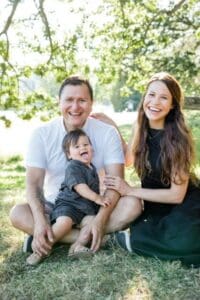
Daniel Cabrera and family
Daniel Cabrera, MD, MPH, he/him/el, Clinical Assistant Professor in the Department of Medicine and a Hospitalist at Harborview Medical Center
“Being a first generation Mexican-American is one of the largest and most important pieces of my overall identity. I hold a lot of pride in calling myself Latino, especially in the field of medicine where Latinx folk are underrepresented.
I grew up in a home where food was made with love and gifted to anyone who came over to visit. So it’s no surprise that years later, I am foodie who still wants to keep those traditions. My wife and I love to host and feed others. I’m talking meals where there are guaranteed to be tons of leftovers and no guest will leave us hungry. Food is love and family.
To me, inclusivity would be a place where those who have been historically excluded from medicine would finally have collective power to create change for the betterment of marginalized communities.”
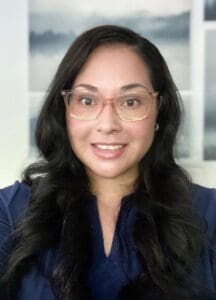
Elina Serrano
Elina Serrano, MD, MPH, she/her, General Surgery Resident
“I was born in Los Angeles but grew up in Jalisco, Mexico. Jalisco is known for mariachi and tequila, and it is also the birthplace of famous rancheras singer Vicente Fernández, muralist José Clemente Orozco, and one of my favorite Latin American writers, Juan Rulfo, among others. If I could describe the aspects of my Mexican culture that bring me the most joy and pride in three words, it would be familia (blood relatives and chosen family), music and food. Familia, music and food are at the center of most Mexican celebrations.
My favorite cultural celebration is Día de los Muertos. While attending elementary school in Mexico, it was customary to make a class altar every year. Students would bring photos of their loved ones who had passed away and decorate the altar with ofrendas (offerings), which consisted of sugar skulls, candles, pan de muerto, cempasúchil (marigold) flowers, and the deceased’s favorite foods and objects. After school, we would join our families and make our way to the cemetery, bringing with us live mariachi music and ofrendas to decorate our loved ones’ gravestones.
While I am no longer able to visit my grandparents’ gravestones during Día de los Muertos, I still take this time in late October and early November to reflect on the many lessons that my grandparents taught me. Some of the ways I choose to honor my ancestors is by providing culturally sensitive and language-concordant care to my Spanish-speaking patients and their families, and by working toward creating a more inclusive physician workforce that better represents the Latino communities that we serve.”

Evelin Jones
Evelin Jones, she/her, Research Coordinator for Latinx Study (Diabetes Institute) and Blossom Study (Kidney Research Institute)
“I was born and raised in Buenos Aires, Argentina. I have a huge group of Argentinean friends here in Seattle. We love gathering (juntadas), where we all get that sense of “gran familia” that we miss so much by being so far away from home.
Cooking and eating together are very important things. Nothing better than “milanesas,” “empanadas,” “locro,” “asado con choripan y chimichurri” or simply anything with a lot of “dulce de leche”; having “mate” (a traditional green tea) or enjoying a bottle of Malbec are all good occasions to listen to Rock Argentino or any other type of music that make us reminiscent of the good old party times at home.
Soccer games with the Argentinians are crazy! When Argentina’s team plays is the time we all forget our favorite teams and the rivalry among them and become one team. We are trying to figure out how we will get together and watch the World Cup games coming up since most of the games will be around 6 a.m. here. Common factors during games are yelling, not keeping it calm at all and wearing “la celeste y blanca.” The white and blue of our flag represents the beautiful sunny skies throughout our country.
My Hispanic roots are very deeply ingrained in me. I feel very fortunate that by working in community research I can focus on the frequently underserved Hispanic community by helping with advocacy and education.
As much as I love having an Argentinean group of friends, I really enjoy interacting and learning from people from other Latin American countries.
I think there is something awesome we can learn from every culture, I wish we could live in a society where if you have an accent, it shouldn’t be something to make fun of, because it means that you are bringing something unique to share with people. Different cultures should be embraced for enriching society and making us all stronger together.”

Lorena Alarcon-Casas Wright
Lorena Alarcon-Casas Wright, MD, she/her/ella, Clinical Associate Professor of Endocrinology
“My culture, my Mexican culture, means to me, my values, traditions, my moral compass, and that ultimately shapes the way I and my family live. We are very family-oriented, we have strong family values. My best friends are my cousins. We love to get together to talk, enjoy food and after we eat, we move the tables and leave room to dance! Our gatherings include family members of all ages, from grandparents to babies, three to five generations, we all catch up on what is going on in our lives, sincerely care and help each other. We love to celebrate holidays together and we have many traditions and rituals.
My favorite Mexican tradition is ‘Dia de Muertos’ or day of the dead. It is a pre-Hispanic celebration where families get together. Our dead ancestors are the guests of honor! Day of the Dead is a time to remember our loved ones who have died and celebrate their memory. It is a joyful celebration, where we get to “spend time” with the people that are not physically with us anymore. We welcome their souls in our memories and have gatherings that include creating altars, where we place their pictures and some of their favorite foods and drinks. We even celebrate and remember our dead pets. It is a spiritual holiday that reminds us that when we have the people we love in our memories, they never die. During this time of the year, we drink homemade chocolate, eat ‘pan dulce,’ and other very elaborate and delicious meals such as tamales, mole, sweet pumpkins.
Inclusivity is making sure we all participate and we all have our voices heard and our opinions counted. Just like in our Mexican families, our gatherings are multigenerational, we take the perspectives of our very experienced elders to the refreshing ideas of our young ones. When we make sure we include everyone, we take all points of view, and as a country, as many of us come from different backgrounds, our different ways to see the world and experiences growing up would allow for creativity and unique ways to solve problems, new ideas, create new opportunities to grow, making us stronger.”

Luis Tulloch-Palomino
Luis Tulloch-Palomino, MD, he/him, Attending Physician, Infectious Diseases, VA Puget Sound Health Care System
“To me, culture is the shared experiences and values of people with common geography, history or both. As a first-generation immigrant from Peru, I feel a deep connection with immigrants from all over the world because we have all overcome similar obstacles to succeed in this country. As a community, I feel that we value dedication and perseverance.
I love food, and I was very lucky to have grown up in a country where the cuisine combines Andean, Asian and European influences. My favorite traditional dishes are chupe de camarones, a seafood chowder, and pepian, a corn stew. Both are staples in the north of Peru, where I grew up.
To me, inclusivity means ensuring that everyone has the same opportunity to succeed regardless of their situation. When I think of inclusivity, I remember a couple of people who helped my family when we first arrived in Seattle. The first was a social worker assigned to us by King County. She always went above and beyond to ensure that we had everything that we needed to thrive, from essentials like school supplies to the young adult novels that I read to practice English – Goosebumps. The second was a family friend who would drop me off at the bus stop on his way to work after my family had to move out of the school district halfway through the year. By taking the time to make our life a little easier, these people made us feel included, like we were worth the time.”

Maria Alejandra Tortorici
Maria Alejandra Tortorici, PhD, Staff Scientist in the Veesler Lab, Biochemistry Department
“My culture is reflected on who I am. I was born in Argentina from Argentinean parents and Italian grandparents that emigrate from Italy to Buenos Aires when things in Europe were extremely difficult because of the world wars.
I got a BS degree in Biological Sciences from the University of Buenos Aires and a PhD from the University of La Plata in Argentina. I did postdocs in the U.S. and France. In France I got a permanent position at the Pasteur Institute and now I am back in U.S.
Of course I like Italian food — pasta, pizza, risotto — but also Argentinean empanadas and milanesas! You should try them, there are a couple of good Argentinean restaurants in Seattle!
To me, inclusivity is to have all the same opportunities to do what we want to do in our lives. We need to work a lot to be inclusive, but the good news is we are already working on it!”
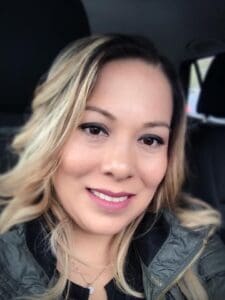
Maria Manriquez
Maria Manriquez, Financial Access Clearance Team Supervisor
“My heritage focuses mainly on family values. From a young age, I have been close to my family and that has greatly impacted my work at UW. I believe it is vital to have close relationships with the people around you by showing compassion and love. This viewpoint has influenced the way I interact with everyone on the team at UW Medicine.
As a result of being close to my family, I cherish every Christmas when our family gets together. Our Christmas consists of listening to Latin music, eating authentic Mexican cuisines, and singing karaoke until we open our presents. My favorite artist is Selena and I personally love to dance cumbia.
Inclusivity is the creation of a workplace that fosters everyone’s opinions equally. It is about giving equal access and opportunities to everyone.”

Monica Sanchez-Contreras
Monica Sanchez-Contreras, MD, PhD, Acting Instructor, Department of Laboratory Medicine and Pathology
“I am from Pereira, Colombia. Colombian culture is an important part of me and defines how I perceive the world around me and how I interact with it. We are very passionate about what we do which has guided me throughout my scientific career. We appreciate all kinds of people we work with and this has made me respectful about other cultures and find the best of every person. Our life is centered on our families and this constantly reminds me of why I do what I do and why I want to succeed.
My favorite food is arepa paisa, a type of corn cake on which you can spread butter alone or add cheese. Arepas are very popular in the region of Colombia that I am from, you can eat them with almost any meal and the best ones are the ones you get in the street, made by ladies that know how to make them from scratch.
For me, inclusivity is a positive attitude toward foreign people that facilitates exposure to different ways of thinking and behaving. In my experience, better and more universal solutions can be developed by contrasting traditional to new approaches to the same problem.”

Rhonda Rodríguez
Rhonda Rodríguez, she/her, Patient Service Specialist
“When I think about my heritage, a sense of deep love and pride quickly surfaces. I am filled with a huge amount of respect for my parents having arrived at a young age from their native countries. I am humbled by the hardships they overcame to raise a family with scant means. My culture represents a group of hard-working individuals full of passion for who they are and for what they strive to accomplish. There is resilience, perseverance and an immense commitment to continue traditions and keep alive our native language.
I cherished growing up in Miami, surrounded by beautiful beaches and the liveliness and cultural richness added by the mix of Caribbean, Central and South American cultures. These, along with the cultures from other countries, truly made it a melting pot! Even within my own household, with parents from Cuba and Guatemala, I was taught the importance of acceptance and appreciation of the cultures of both countries. I felt lucky to enjoy the best of both worlds when it came to the festivities — the food, dancing and different traditions created wonderful experiences! When it comes to choosing which tamal is my favorite — Cuban or Guatemalan — it’s still a tie! Exposed to the beauty of different music, food and art allowed me to appreciate the gems I was surrounded by and allowed me to have respect for each country. Naturally, this experience opened my mind to inclusivity at a very early age.
Inclusivity feels like an accepting and welcoming place that recognizes the strengths and unique qualities of individuals from different cultures. When observing my work environment, it’s comforting to see that more and more I am surrounded by people who share my language and heritage. I feel that by creating an environment of understanding and acceptance our patients also feel that connection. The care they experience is enhanced by being provided for by staff members who better understand them and their situations. It is quite extraordinary to be a part of a team that is doing our part in providing equitable care!”
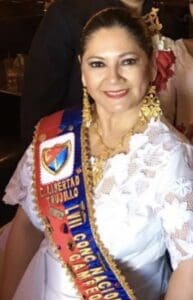
Sonia Nino de Guzman
Sonia Nino de Guzman, she/her, Financial Access Specialist, Enterprise Revenue Cycle (ERC)
“Cultural heritage is the essence of who we are, our music, dances, history and food. It is what we represent in our society. When we get together with family and friends, it’s a good opportunity to teach our children to value their cultural traditions.
Food and music are the root of Peruvian culture so you can imagine all the favorite dishes I have! My top one must be Ceviche which is prepared fresh raw fish cured in fresh citrus juice, red onions, spicy peppers, other seasonings, and served with corn and sweet potato.
As for music, I have dedicated my entire life to Peruvian folk dance and have spent it performing, competing and teaching Peru’s national dance Marinera and other folkloric dances. I am a five-time National Marinera Champion (the most beautiful traditional dance of Peru) and consider it to be my biggest passion in life.
As for Peruvian writers, Mario Vargas Llosa is my favorite, and for music artists I enjoy Eva Ayllon (female singer, one of Peru’s foremost Afro-Peruvian musicians), Gian Marco (Peruvian singer-songwriter and actor), Daniela Dancourt (salsa singer and dancer) and Juan Diego Florez (opera singer).
Inclusivity to me means being valued for not just the work I do but for who I am as an individual. Each of us has unique life experiences, strengths and perspectives which deserve to be heard and acknowledged. A focus on inclusivity ensures that space exists for all of us.
Throughout my time here in United States, I’ve felt that there’s a space for my students, co-workers and I to express ourselves, our culture and even when there are differences, we value and respect one another.
That is inclusivity and the fact that this is encouraged and made a priority is something I truly value.”
Editor’s note: Responses were lightly edited for length, clarity and style.
